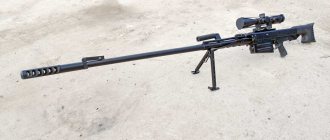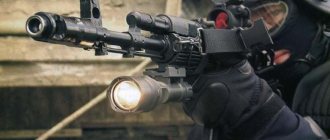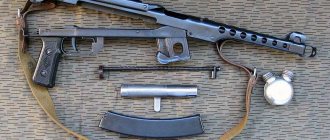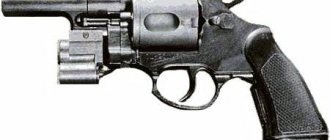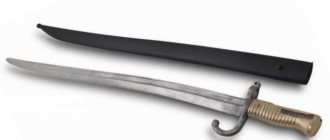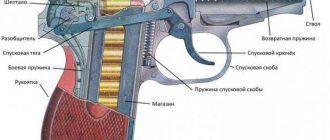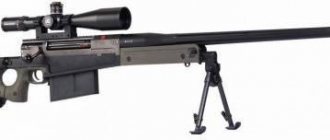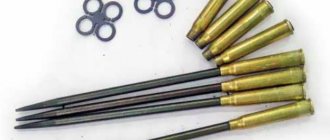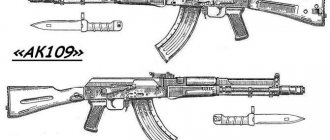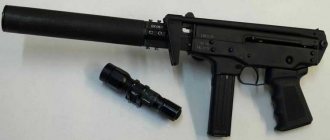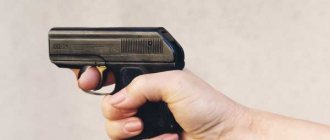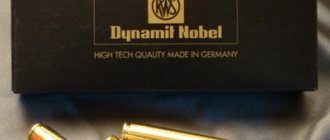Throughout the existence of firearms, the main task of designers was to increase the rate of fire. This statement also applies to pistols: Mauser was the first to conduct such experiments, adding an automatic firing mode to his successful short-barrel in many respects.
In the Soviet Union, Stechkin succeeded in this matter, creating a fundamentally new APS, which by now is already outdated. In the mid-90s, the subject of our discussion today appeared - the OTs-33 Pernach pistol.
History of origin
In 1951, the newest APS pistol (Automatic Pistol Stechkin) entered service with the Soviet army. The range of use of such weapons was very wide: equipping the crews of combat vehicles and other staff units that were not entitled to a carbine or machine gun according to the regulations. It became the weapon of privates and sergeants in special forces, and a number of these pistols were also in service with the Ministry of Internal Affairs.
The weapon was somewhat controversial in terms of convenience and design, but was widely used by Soviet and Russian troops in a large number of armed conflicts until the early 2000s. However, time dictated its requirements, so in 1958 it was discontinued. A further development of the APS, which had become obsolete after 40 years of combat service, was the OTs-23 “Dart”.
OTs-23 is an automatic pistol chambered for 5.45x18, developed by order of the Ministry of Internal Affairs, whose chief designer was the same Igor Stechkin.
Despite the quite successful design, the “Dart” was not widely used due to its cartridge, which practically did not provide a stopping effect and had an extremely low bullet mass. Currently, this weapon is not found almost anywhere due to the initial non-compliance with customer requirements.
The Ministry of Internal Affairs of the Russian Federation rejected the new pistol, but due to unsatisfied needs, it soon again sent an application to TsKIB SOO for the development of a similar weapon, but chambered for the classic 9x18 cartridge in both of its modifications (PM and reinforced PMM). In 1995, development began, and a year later the first prototype was released, fully satisfying the requirements of the Ministry of Internal Affairs.
Having relatively rich experience in the development of self-loading automatic pistols, TsKIB SOO under the leadership of I. Ya. Stechkin in 2002 presented to the general public a redesigned and improved OTs-23, which was now called OTs-33 “Pernach”. Built on the basis of the “Dart”, “Pernach” had the same automation scheme and a double-action trigger, which allowed both single and automatic fire.
Photo OTs-33 Pernach
Similar
AK-47 assault rifle cartridge caliber 7.62 mm.
Device. Rate of fire AK-74 assault rifle cartridge 5.45 mm caliber. Device. Rate of fire
Dragunov SVD sniper rifle caliber 7.62 mm. Device
AKS-74U assault rifle cartridge caliber 5.45 mm. Device. Weight
Mauser K96 pistol cartridge caliber 7.63 and 9 mm. Device
Pistol Walter PP / PPK cartridge caliber 7.65 and 9 mm. Device
Pistol Yarygin PYa Grach cartridge caliber 9 mm. Device
DShK machine gun cartridge caliber 12.7 mm. Device. Rate of fire
Luger pistol R.08 Parabellum cartridge caliber 9 mm. Device
Pistol PM cartridge caliber 9 mm. Rate of fire. Dimensions. Bullet speed. Sighting range
Self-loading shotgun Saiga-12 cartridge, caliber. Device
Maxim machine gun cartridge caliber 7.62 mm. Device. Weight
PPSh-41 Shpagina submachine gun cartridge caliber 7.62 mm
APS Stechkin pistol cartridge caliber 9 mm. Device
Nagan system revolver cartridge caliber 7.62 mm. Device
Kalashnikov PK machine gun and PKM cartridge caliber 7.62 mm. Device
Simonov carbine SKS-45 cartridge caliber 7.62 mm. Device
Rifles and carbines Mauser 98 caliber 7.92 mm. Device
PPS-42 and PPS-43 Sudaev submachine gun cartridge caliber 7.62 mm
Pistol Walter P38 cartridge caliber 9 mm. Device
MP-40 German submachine gun cartridge caliber 9 mm. Device
VSS Vintorez sniper rifle caliber 9 mm. Device
Submachine gun PP-91 Kedr cartridge 9 mm caliber. Device
Light machine gun RPK-74 cartridge caliber 5.45 mm. Device
Pistol Glock 17 cartridge caliber 9 mm. Device
Makarych, Izh-79-9T, MR-79-9TM, MP-80-13T traumatic pistol
AK-12 assault rifle cartridge caliber 5.45 mm. Device. Weight
Mosin rifles and carbines Three-line caliber 7.62 mm
PMM Makarov pistol modernized 12 rounds. Device
Revolver Colt Single Action Army (SAA) Peacemaker. Device
Machine gun PKP Pecheneg cartridge caliber 7.62 mm. Device
Sniper rifle VSSK Exhaust caliber 12.7 mm. Device
Beretta pistol 92 cartridge caliber 9 mm. Device
TT - Tokarev pistol cartridge caliber 7.62 mm. Device
Submachine gun PP-19 Bison cartridge caliber 9 and 7.62 mm. Device
Sniper rifle SV-98 caliber 7.62 mm. Device
Vladimirov KPV machine gun cartridge caliber 14.5 mm. Device
ASH-12 assault rifle cartridge caliber 12.7 mm. Device. Rate of fire
PSM pistol cartridge caliber 5.45 mm. Device
Pistol Colt M1911A1 cartridge caliber 45. Device
Smith-Wesson revolver Russian cartridge, caliber 10.67 mm. Device
Degtyarev DP-27 light machine gun, 7.62 mm caliber cartridge. Device
Shotgun Mossberg 500 Cartridge. Dimensions. Rate of fire. Sighting range
Thompson submachine gun cartridge caliber 11.43 mm. Device
Pistol USP Heckler und Koch cartridge, caliber. Device
Hunting carbine OSK-88 (SVT-40) caliber 7.62 mm. Device
AS Val silent automatic cartridge caliber 9 mm. Device
Submachine gun PP-19-01 Vityaz cartridge 9 mm caliber. Device
Machine gun Kord cartridge caliber 12.7 mm. Device. Weight. Sighting range
Osa - traumatic pistol cartridge, caliber. Device
AK-9 assault rifle cartridge caliber 9 mm. Device. Rate of fire
Degtyarev RPD light machine gun, 7.62 mm caliber cartridge. Device
Automatic OTs-14 Groza cartridge caliber 9 mm and 7.62 mm. Device
Czech pistol CZ-75 (modifications). Device
Browning pistol 1903 cartridge caliber 9 mm. Device
Sniper rifle OSV-96 caliber 12.7 mm. Device
FN P90 submachine gun cartridge caliber 5.7 mm. Device
Submachine gun OTs-02 Cypress cartridge caliber 9 mm. Device
Sniper rifle ASVK Kord caliber 12.7 mm. Device
Automatic AEK-971 Cartridge. Caliber. Device. Rate of fire
Steyr AUG assault rifle (A1, A2, A3) cartridge caliber 5.56 mm
AK series 100 assault rifles. Modifications. Device. Weight. Dimensions
Uzi submachine gun. Cartridge. Caliber. Rate of fire
Pistol SR1M Gyurza cartridge caliber 9 mm. Device
Pistol GSh-18 cartridge caliber 9 mm. Device
SVDK sniper rifle caliber 9.3 mm. Device
Automatic SR-3M Whirlwind cartridge caliber 9 mm. Device
Machine gun NSV-12.7 Utes cartridge, cal. Device. Weight
Kalashnikov RPK light machine gun cartridge caliber 7.62 mm. Device
Sniper rifle VSK-94 caliber 9 mm. Device
Vostok-1 (Jorge-3M) 9mm caliber traumatic pistol. Device
Degtyarev PPD submachine gun cartridge caliber 7.62 mm
English sniper rifle L96A1 cartridge, caliber
M1 Garand rifle cartridge caliber 7.62 mm. Device
Desert Eagle pistol. Device
Smith-Wesson revolver (modifications). Device
Automatic rifle HK G36 (E, K, C, KE) cartridge caliber 5.56 mm
Pistol P-96 cartridge caliber 9 mm. Device. Rate of fire
Pistol GP35 Browning High Power cartridge, caliber. Device
Assault rifle FN SCAR (L, H) cartridge caliber 5.56 and 7.62 mm
Revolver Lefoshe M1856 cartridge caliber 11 mm. Device
Submachine gun PP-90 cartridge caliber 9 mm. Device
AN-94 Abakan automatic Nikonov cartridge caliber 5.45 mm. Device
Submachine gun PP-2000 cartridge caliber 9 mm. Device
Mauser pistol HSc cartridge caliber 7.65 and 9 mm. Device
M16 automatic rifle cartridge caliber 5.56 mm. Device
Fedorov assault rifle cartridge caliber 6.5 mm. Device. Rate of fire
Pistol Baltiets cartridge caliber 7.62 mm. Device
Strizh pistol cartridge caliber 9 mm. Device. Weight. Sighting range
Browning pistol 1910 cartridge caliber 7.65 and 9 mm
Silent pistol PSS Vul cartridge caliber 7.62 mm. Device
Pistol SIG-Sauer P226 cartridge caliber 9 mm. Device
Pistol OTs-27 Berdysh cartridge caliber 7.62 mm and 9 mm. Device
AK-107 assault rifle cartridge caliber 5.45 mm. Device. Rate of fire
OTs-44 sniper rifle, caliber 12.7 mm. Device
German machine gun MG3 cartridge caliber 7.62 mm. Device
Self-loading shotgun Browning Auto-5 cartridge, caliber. Device
Submachine gun AEK-919K Kashtan cartridge caliber 9 mm. Device
PB pistol silent cartridge 9 mm caliber. Device
Pistol OTs-33 Pernach cartridge caliber 9 mm. Device
Hunting carbine KO-98 cartridge caliber 7.92 mm. Device
TK (Korovin pistol) caliber 6.35 mm. Device. Weight. Dimensions
Underwater assault rifle APS cartridge caliber 5.66 mm. Device
Pistol OTs-21 Malysh cartridge caliber 9 mm. Device
American M60 machine gun, 7.62 mm caliber cartridge. Device
MTs-116M sniper rifle, caliber 7.62 mm. Device
Automatic 9A-91 cartridge caliber 9 mm. Device. Rate of fire
Submachine gun PP-93 cartridge caliber 9 mm. Device
VAG-73 - Gerasimenko pistol. Device. Weight. Dimensions
Cordon-5 is a traumatic pistol. Device. Weight. Dimensions
Goryunov SG-43 heavy machine gun cartridge caliber 7.62 mm. Device
Webley revolver cartridge, caliber. Device. Dimensions. Weight
Machine gun AEK-999 Badger cartridge caliber 7.62 mm. Device
RP-46 machine gun, 7.62 mm caliber cartridge. Device. Rate of fire
Sniper rifle VS-8 cartridge caliber 8.6 mm. Device
Slostin machine gun cartridge caliber 7.62 mm and 14.5 mm. Device
Assault rifle Tavor TAR-21 cartridge caliber 5.56 and 5.45 mm
Submachine gun SR-2 Veresk cartridge caliber 9 mm. Device
Lancaster pistol cartridge caliber 12.1 mm. Device. Rate of fire
Submachine gun PP-90M1 cartridge caliber 9 mm. Device
Underwater pistol SPP-1M. Device. Weight. Dimensions
Traumatic pistol MP-461 Guard. Device. Weight. Dimensions
Lebel rifles and carbines are cartridgeed in 8 mm caliber. Device
Automatic A-91 cartridge caliber 7.62 mm. Device. Rate of fire
M14 automatic rifle cartridge caliber 7.62 mm. Device
Revolver Smith & Wesson Model 10 Military & Police
Automatic rifle FN FAL cartridge caliber 7.62 mm. Device
Submachine gun STEN MK 2. Device. Weight. Dimensions
Traumatic pistol IZH-78-9T Chain mail cartridge caliber 9 mm
Leader-M traumatic pistol 11.43×32T. Device. Weight. Dimensions
Ingram M10 and M11 submachine gun. Device. Weight. Dimensions
Pistol Steyr M9-A1 cartridge caliber 9 mm. Device. Weight
Pistol OTs-23 Dart cartridge caliber 5.45 mm. Device
Berthier rifles and carbines caliber 8 mm. Device
Automatic shotgun USAS-12 cartridge caliber 18.5 mm
Sniper rifle VS-121 caliber 7.62 mm. Device
Traumatic pistol MP-353 cartridge, caliber 11.43 mm
Tiss machine gun cartridge caliber 9 mm. Device. Rate of fire
Traumatic pistol MP-355 cartridge caliber 9 mm. Device
Automatic double-medium ADS cartridge caliber 5.45 mm. Device. Rate of fire
Traumatic pistol MP-81 cartridge caliber 9 mm. Device
Pistols Zastava 70 and 70(k), cartridge caliber 7.65 or 9 mm. Yugoslavia
Sniper rifle GALATZ (Galil) cartridge caliber 7.62 mm
Pistol MP-444 Bagheera cartridge caliber 9 mm. Device
Revolver Colt New Army / Navy. Device. Bullet speed. Sighting range
Type 64 is a Japanese automatic rifle. Device
Performance characteristics in comparison with analogues
The automatic operation of the pistol operates according to a blowback design, which ensures a high rate of fire, as well as ease of production and maintenance, but contributes to fairly rapid wear of the weapon. The return spring is located under the barrel. The trigger mechanism is hammer-operated, self-cocking, double-action.
In terms of ergonomics, the OTs-33 is a fairly comfortable weapon. Unlike the APS, which had a bulky and inconvenient butt-holster, the Pernach pistol is equipped with a framed metal butt that is attached to the belt while carrying the weapon. The controls are located symmetrically, which allows you to conveniently fire with a two-handed grip, as well as successfully use the pistol even for left-handed people.
OTs-33 "Pernach" has several analogues in foreign armies.
These include the Glock 18, Beretta 93R, the Austrian small-sized automatic pistol SteyrTMP, as well as the APS.
Below is a table comparing the characteristics of these generally similar models.
| OTs-33 Pernach | APS | Glock 18 | Steyr TMP | |
| Cartridge | 9x18 PM | 9x18 PM | 9x19 | 9x19 |
| Magazine capacity | 18 or 27 | 20 | Options from 17 to 33 | 15 or 30 |
| Sighting range, m | 50 | 200 | 50 | 50-100 |
| Rate of fire, VVM | 800-900 | 700-750 | 1200 | 800-900 |
| Weight, kg | 1.15 | 1.02 | 0.58 | 1.3 |
As can be seen from the comparative table, the OTs-33 is on average heavier than its analogues, and is 200-300 rounds per minute inferior to some Western classmates in rate of fire. However, in other respects it is located in the same “weight category”, being a strong middle peasant in the class of automatic pistols, both in Russia and in the world, which makes it a reliable and effective weapon.
Video of the SPP-1M pistol
https://youtube.com/watch?v=-1ZcaQAV1V8
The task for the development of an underwater pistol complex for arming scuba divers was issued in 1968. From several schemes - using the active-reactive and active throwing principles - “ active" circuit. The weapon was developed as a multi-barreled non-automatic weapon.
The development of weapons at TsNIITOCH-MASH was carried out by V.V. Simonov (great-nephew of the famous domestic gunsmith S.G. Simonov), the 4.5-mm SPS cartridge - P.F. Sazonov and O.P. Kravchenko. The work was carried out in collaboration with the Tula Arms Plant. In 1971, the SPS cartridge and a four-barreled pistol for it were adopted for service. The pistol received the designation SPP-1 (“special underwater pistol, first model”).
The conditions under which a bullet moves under water are radically different from its movement in the air. The bullet, having left the barrel, will enter an environment that differs from air in density (and it is 800 times higher), pressure, and viscosity. Moreover, water is incompressible. A bullet with an insignificant relative elongation (the ratio of the length of the bullet to the caliber) will simply tip over; the gyroscopic effect will not ensure stability of movement of such a bullet in water. However, if you move to a different barrel and bullet design, the disadvantages can be turned into advantages.
The bullet of the SPS underwater cartridge has a mass of 13.2 g of high elongation (about 25:1 - bullet length 115 mm) with a blunt nose. The stability of the movement of such a bullet under water is ensured by the formation of a cavitation cavity (cavity) around it almost along its entire length - the phenomenon of hydrodynamic cavitation manifests itself when the bullet moves in water at high speed. The cavitation cavity helps stabilize the bullet's movement. And since there is no need to “twist” the bullet in the barrel, the shot is fired from a smooth barrel through which the bullet travels with a gap. The SPS cartridge case has a protruding rim.
The effective firing range of the SPS cartridge bullet under water decreases with increasing depth, but in all cases exceeds the line-of-sight range at the corresponding depth. At the same time, the bullet ensures reliable defeat of an enemy in a wetsuit. In addition, SPP can be used to protect swimmers from dangerous marine predators.
The pistol has a folding block of four barrels. The block is hingedly mounted on the axles of the frame and is folded down for loading and reloading, as in “breaking” hunting rifles. This scheme corresponds to a large cartridge length - 145 mm. Loading is carried out by a clip in which four cartridges are fixed. The spent cartridges are simultaneously removed with the clip. The self-cocking firing mechanism includes a firing pin rotating in a transverse plane and ensures consistent firing from the barrels. With each press of the trigger, the firing pin rotates 90° and, moving along the screw pattern, breaks the primer of the next cartridge.
On the left side, in the recess of the handle, there is a non-automatic safety box, which also ensures locking of the barrel block. The sighting device includes an open front sight and a constant rear sight. The SPP-1M pistol (1979) has a spring that facilitates the trigger, and the enlarged trigger guard allows shooting in three-fingered insulated swimmer's mittens.
The pistol is carried in a closed belt holster made of artificial leather. 12 cartridges in clips are placed in metal cases. The production of the 4.5 mm SPP-1M pistol, as well as the 5.6 mm APS underwater assault rifle, was organized at the Tula Arms Plant. This set of weapons for scuba divers has no direct foreign analogues.
In the service of government agencies
OTs-33 has not received such wide distribution as the APS. As of 2022, it is in service with several special units of the Ministry of Internal Affairs of the Russian Federation.
Due to the use of the pistol from 2002 to 2012 in the army (but not in combat), Pernach users have a special opinion about this weapon, which, unlike the APS, has less negativity. The objects of criticism include the shoulder rest-butt, which is too short for most shooters.
The weapon controls are located conveniently for the hand; when the safety is engaged (which is also a switch for firing modes), the pistol becomes safe to carry. Under the barrel there is a mount for a laser target or tactical flashlight.
For carrying, there is also a pouch with three spare magazines, worn together with a detachable shoulder rest.
As a result, Igor Stechkin and TsKB SOO managed to create a successful (as proven by forty years of service in the army) pistol, which successfully continued the ideas and developments begun by Igor Yakovlevich back in the 50s. The design bureau of Igor Yakovlevich provided the Ministry of Internal Affairs with simple and reliable weapons that remain relevant today.
Nothing stands out
According to the editor-in-chief of the Kalashnikov magazine, Mikhail Degtyarev, by modern standards, Pernach is not of any interest. However, even at the time of its creation, the pistol did not have any distinctive features, so from the point of view of the weapons industry, there is absolutely nothing remarkable about it, the expert noted.
It has not been used in special units of the Ministry of Internal Affairs and other structures since the 90s. It is in service only formally. This pistol was developed without regard to, let's say, world experience. This is currently an obsolete product. It was only of structural engineering interest, not operational. Not used and practically never used. Very few of them were made. There is very little operating experience. “Nothing stands out,” said Degtyarev.
OTs-33 “Pernach” can hardly be found in the ranking of “the most popular pistols in Russia.” The most famous are the Makarov, Lebedev, and Yarygin pistols. One of Stechkin’s latest inventions did not receive universal recognition, and “went into the sunset” much earlier than some of its predecessors. However, many people remember this product with nostalgia, even despite its shortcomings.
It is important to note that technology in Russia is constantly being modernized. Now in service in the Russian Federation there are powerful, modern and unique small arms, the analogues of which can hardly be found.
